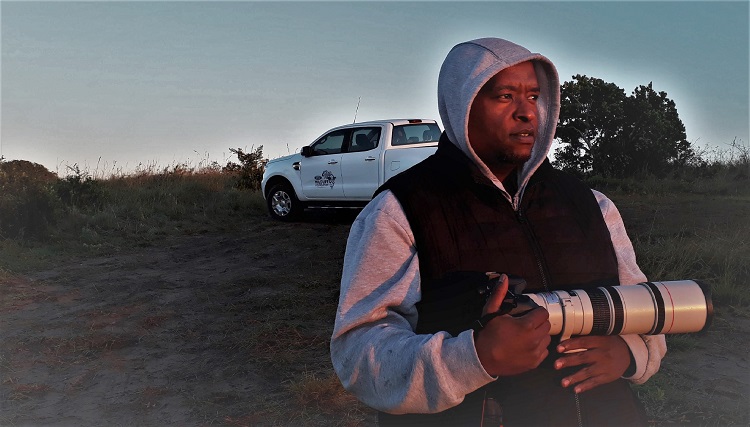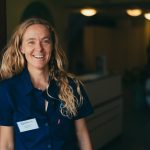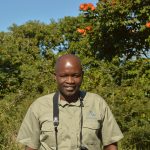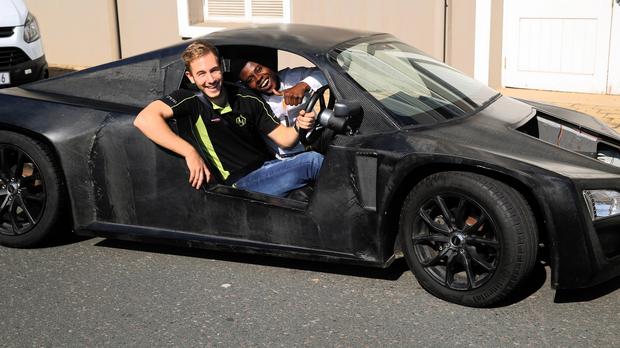Radio personality, entrepreneur, wildlife photographer and activist… that’s some resume. And it’s just as well because Gabriel Sithole needs all the skills he can muster for a tough job.
-
First published in Sunday Tribune
Armed with a camera, Gabriel Stihole, is on a mission to undo the destructive behaviour of people by documenting the wonders of the natural world around us.
He also hopes to teach folk not to reach for a stick every time they see a snake.
When Sithole is not behind the microphone on Vuma 103 FM breakfast show, he is out and about in a Ford Ranger working with Roving Reporters and other organisations in documenting some of the most critical challenges facing conservation efforts in South Africa.
Sithole is a brand ambassador for the Ford Wildlife Foundation which supports conservation education and research. It’s a relationship which allows Sithole to put his favourite passion to good use: wildlife photography.
Sithole has had a curiosity for cameras from a young age.
“My dad used to have a camera, but he would hardly let me play with it because it was very expensive back then. You had to buy film for the camera. Once your film was full, you had to go and get it developed, which was not so cheap,” said Sithole.
Finally he got a chance to own his first camera while on a school rugby trip to the United Kingdom in 1998.
As years passed he realised the pictures he enjoyed taking most were of animals, nature and landscapes.
“I would take pictures and post them on Facebook for people to see. That was in the early days of getting into photography – in the mid-2000s,” said Sithole.
In 2010 Sithole stepped up his picture taking game after meeting a few photographers who specialised in bird photography.
“They gave me pointers about how to improve my photography and how I could making a living from it,” said Sithole.
It was not long before Sithole’s passion caught the attention of Ford Wildlife Foundation.
Sithole reckons the world’s biggest challenge is “the nonchalant attitude people have towards nature”. His favourite pearl of wisdom is the saying: “The more I learn, the more I realise how little I know.” The saying dates back to the age of the Greek philosopher, Socrates. It encapsulates the fact that more you learn, the more you realize how much more depth there is to that subject. In Sithole’s eyes, this is particularly true when it comes understanding the wonders of the world.
Sithole rates as his most memorable life moment so far, seeing a mature Leatherback turtle digging for a nest to lay her eggs in Sodwana Bay – “probably on the exact same beach on which she herself had hatched from an egg before I was even born.”
For a long time it has been a mystery how mature loggerhead and leatherback turtles navigate thousands of kilometres, returning from feeding grounds to nest on the very beaches where they hatched at least 15 years previously. Latest studies reveal that sea turtles use lines of magnetic force, rather like GPS, to navigate where they are going. This ultimately enables these sea turtles to return, when ready to breed, to the exact spot where they were born to mate and lay their own eggs .
While Sithole today rubs shoulders with leading wildlife conservationists, he says it was his mother who has most inspired his life’s journey.
“She’s a much more passionate wildlife enthusiast than I am, even though, she has never been to school formally. Everything she knows is self-taught. It is through the impossible that she makes possible, that I draw strength and enormous courage,” says Sithole.
He has fond memories of herding cattle in the rural community of Eshane in Greytown where he grew up.
“It was a simple lifestyle where man and nature lived in harmony. You use what nature offers – from wildberries, to wild honey.”
As a young boy, he also witnessed how many people in rural communities misunderstood snakes.
He believes the misconceptions that people have about snakes, and an associated aggressive response, has led to an increase in snakebites in KwaZulu-Natal. So Sithole runs courses on snake safety and handling with a view to educating people – young and old – about the important role snakes play in the natural order.
He also plans to publish two wildlife books, focusing on Southern African land mammals and birds. “I wish for these books to eventually be incorporated at school level, where wildlife and nature conservation can be introduced to youngsters as a subject,” says Sithole.
And once his life’s mission is complete, Sithole wants to spend his last year’s of life in one of the most isolated places in the world: “Mongolia with it’s golden eagles and wolves”. – Bukeka Silekwa. (Additional reporting, Fred Kockott)
- Bukeka Silekwa is a Rosebank journalism graduate taking part in a Roving Reporters environmental journalism training programme supported by the Human Elephant Foundation.
Featured image caption: Gabriel Sithole at work in the iSimangaliso World Heritage site. Photo: Izze Siemann

Click here to read other Sunday Tribune Game Changer profiles.
Amaqhawe Awards
At the recent launch of the Sunday Tribune Amaqhawe Awards, Gabriel Sithole presented award-winning quality photographs to five deserving Game Changers of his choice.

This photograph of a lilac breasted roller was awarded to Keith Cooper, a former conservation director for the Wildlife and Environment Society of South Africa (WESSA). Cooper hardly needs much introduction in conservation circles, and it would take too long to list all his accomplishments. He has put a stop to illegal beach cottages on the Wild Coast, lobbied for land in the Hluhluwe-Imfolozi Corridor to be incorporated into two nature reserves, and started Bergwatch to monitor our mountain heritage. He is now helping to rehabilitate forests in Karkloof – a 15 hectare pine plantation has been felled and replaced with indigenous tree such as the endangered black stinkwood. With the land returning to its natural state, creatures including the Cape parrot, eastern bronze-naped pigeon, and dwarf chameleon have been returning. Click here to read the Game Changer profile of Keith Cooper.

This photo of a pelican was awarded to Samson Phakathi, a Howick-based environmentalist. Phakathi spearheads various initiatives of the Endangered WildLife Trust’s Threatened Greenland Species Programme that protects grasslands and the animals and plants species that inhabits them. As a senior EWT fieldworker, Phakathi brings cultural sensitivity and a sound knowledge of the legalities to help combat poaching, engaging directly traditional leaders, school children and their teachers, private landowners, the police and licensed hunters. Click here to read the Game Changer profile of Samson Phakathi.

This photo of a hornbill was awarded to Ayanda Lipheyana, 31, of Mpophomeni township near Midmar Dam. Lipheyana, who drives various environmental programmes in Mpophomeni township near Midmar Dam in association GroundTruth teaching young people how to monitor river health and educating them about the consequences of throwing rubbish into a river. Lipheyana, who is in the third year of a Bachelor of Science degree through Unisa, runs a river walk for youngsters every second Saturday. He uses the walks to demonstrates science tools, teaching young people how to monitor river health, including by collecting small animals from the water as samples. Lipheyana also runs civic awareness initiatives that encourage people to appreciate the environment and the sanctity of communal land. Lipheyana received a Wildlife and Enviromental Society of South Africa (WESSA) Award in September 2017, capping a busy four years of conservation work. Click here to read the Game Change profile of Ayanda Lipheyana.

This photo of playful zebras was awarded to Cherise Acker-Cooper for her work with the Endangered Wildlife Trust (EWT). Cooper run’s EWT’s threatened amphibian programme which involves training specialist frog guides, who also serve as local environmental champions. The 40-year-old Amanzimtoti resident is also involved in recruiting people from elsewhere in eThekwini and beyond to train them in conservation related skills, including clearing alien invasive plants, and occupational health and safety. Getting rid of alien plants is an ongoing task and as a useful spin-off creates jobs. Click here to read the Game Changer profile of Cherise-Acker Cooper.

This sunset photo of a giraffe was awarded to Thabo Madlala, an Endangered Wildlife Trust Eco Ranger. Our national bird, the blue crane, and other other African cranes are under threat because of habitat loss, poisonings and powerline collision and if these beautiful birds are to have a future it will be thanks to men like Thabo Madlala. Madlala operates in between Underberg, Swartberg, Franklin, Kokstad and Matatiele, engaging with farmers to encourage them to eradicate alien plants that encroach on the cranes’ habitat. But like charity, conservation begins at home, and Madlala is also doing his bit for nature in the Mqatsheni communal area, north of Himeville, that he hails from. He recently started a hiking club in Mqatsheni and has trained rock art guides to lead hikes and offer homestays for tourists. Click here to read the Game Changer profile of Thabo Madlala.
- The next Sunday Tribune Amaqhawe Awards take place in September at Independent Media, Greyville, Durban. Contact Annie Dorasamy for further information, email: annie.dorasamy@inl.co.za













